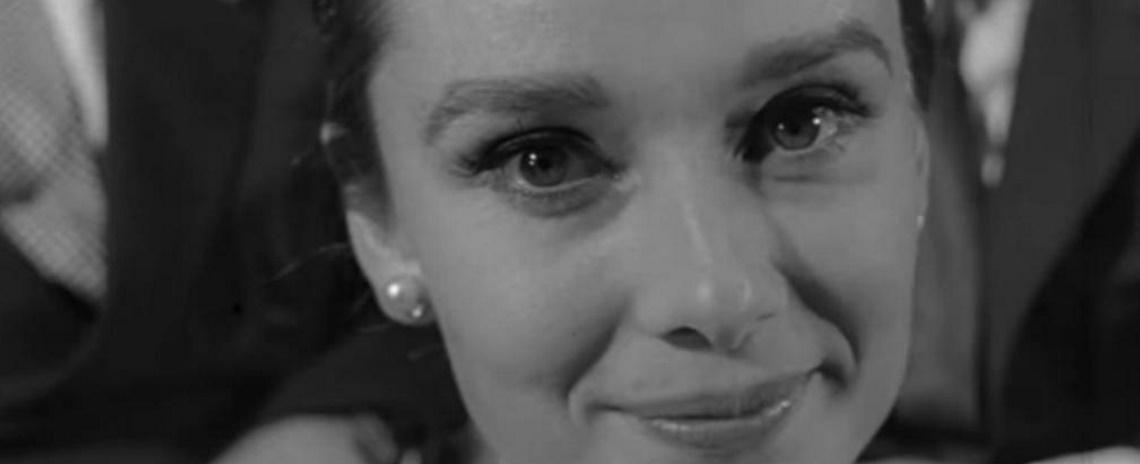Audrey Hepburn: garbed in an elegant black dress and sporting a dazzling necklace of pearls, hair in a chic updo topped with a sparkling tiara, a pair of elbow-length black gloves sheathing both hands, the left delicately pinching a cigarette holder, the right propped squarely under her chin. This image of the Old Hollywood star, her frayed baby bangs and her soft smile and her stylish wardrobe against a bokeh background, is among the most instantly recognizable snapshots of the era. The still is from Breakfast at Tiffany’s (1961) and she’s playing Holly Golightly, the lovably, messily eccentric socialite from Truman Capote’s 1958 novel of the same name, but it doesn’t matter. That single image managed to transcend her entire award-winning filmography, the many struggles of her early life, and the entirety of her late-in-life philanthropy. Although it might be a photo of her, it’s nothing like the real her.
Director Helena Coan’s sophomore documentary Audrey: More Than an Icon sets out to explain exactly why Hepburn deserves to be remembered as something more complex than the pinnacle of mid-20th-century fame, starting with her troublesome childhood in the 1930s. Born in Belgium in 1929 to a Dutch noblewoman and an Austrian banker, Audrey arrived in the world during an extremely uncertain time, both for her family and the European continent: Divorce and war were both imminent, and they would unite to tear her household apart. Her father left and the Nazis invaded, leaving Hepburn to face malnourishment and displacement. Dance was her only solace, and even that was eventually taken from her because of the traumatic circumstances wreaking havoc in her young life.
The struggle Hepburn faced in these formative years would affect everything that followed: her move to Amsterdam to study ballet as a teen in the mid-1940s, her transition to theater as a way to earn some extra money for her family in the late ’40s, and her eventual casting in a series of British musical comedies in the early ’50s that landed her the fateful starring role in Gigi on Broadway. Coan covers the highlights of these first 20-odd years, but she breezes past it all relatively quickly. As a result, her surface-level approach to her subject’s origins merely suggests the reasons why Hepburn should be celebrated for things other than her performances — the filmmaker fails to dig deeply enough to make her point. A little background to familiarize the audience is obviously going to be necessary when covering any subject or making any argument, but Audrey would benefit from a strongly worded thesis in its opening sections.
After Gigi, Audrey had it made. For the next 15 years, Hepburn hopped from leading part to leading part, easily establishing herself as an A-list superstar whose small stature, warm personality, and affable demeanor provided a more relatable alternative to the blond bombshells, femme fatales, and more melodramatic female leads of the time. From her work in films such as Roman Holiday (1953), Sabrina (1954), and Funny Face (1957) to her collaborations with legendary French fashion designer Hubert de Givenchy to her high-profile marriage to fellow actor Mel Ferrer, Coan continues to blast through the greatest hits of Hepburn’s life. The director manages to touch on seemingly every aspect of Audrey’s personal and public lives, using archival footage, home movies, interviews with historians, family members, and friends, and ill-suited ballet interludes featuring Cats (2019) star Francesca Hayward. Coan paints a hasty portrait that will be familiar to fans and almost certainly disorient newcomers.
With just a half-hour left, Coan reaches Audrey’s final decade or so. Up until this point, despite some details regarding the star’s wartime upbringing, More Than an Icon has largely been unsuccessful in its mission to challenge the Hepburn-as-Golightly image. It initially seems unclear precisely how Coan could manage to argue that Hepburn was better than the sum of her star power when so much time has been spent detailing that very subject. Fortunately, the documentary’s final 30 minutes are spent providing an extensive overview of the actress’s transition from movie star to UNICEF ambassador. Much like her tumultuous childhood, it’s a part of her life that many fans of her films might not even know, and therefore an invaluable part of the documentary.
Helena Coan is right about this: Audrey Hepburn’s righteous efforts to put an end to world hunger during her last years of life makes her more than a glamorous icon. She was not Holly Golightly, a naïve and kooky figure of café society. She was not Princess Ann, a runaway royal hoping to flee her responsibilities and find love in Rome. She was not an irresistible love interest, a charming girl next door, a quiet ballet dancer, or any one role from her impressive list of performances. The real Audrey Hepburn was far more complex, far braver, and far more captivating than just an average icon. Coan’s documentary doesn’t succeed at changing what Hepburn is remembered most for, but looking past its hour’s worth of unremarkable career summation, it’s clear that Audrey: More Than an Icon is a valiant effort to shift the narrative away from the celebrity and toward the person Hepburn was both before and after the height of her stardom.
Rating: B-
Audrey: More Than Icon is now available on DVD and Blu-ray from Bohemia Media. The film will be available to rent from major online platforms on January 5, 2021.


